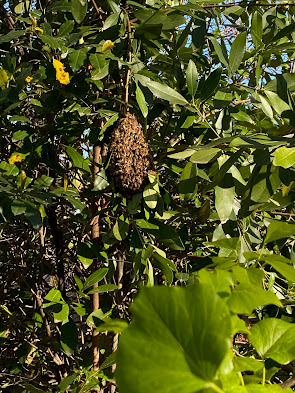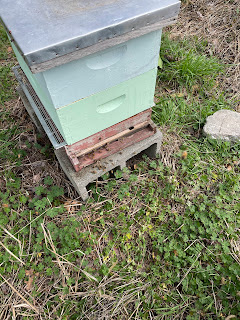It's only Wednesday, but I've been very bee-sy. On Saturday I discovered my community garden hives were both gone...the first died before winter and the second was without a queen (who had been there two weeks ago) and was in terrible shape. I didn't open the hive two weeks ago - just lifted up the top and took off the feeder. The bees were flying in with pollen and I felt pretty sure that we were coming out of winter fine. Then I did an inspection on Sunday and found them broodless and queenless with a tiny diminishing population.
These are teaching hives and the MABA philosophy is that our swarm hotline will supply swarm calls to the teaching hives first until we have two hives for teaching. I called the swarm commander, Dave, and he called me so quickly the very next day, on Sunday, with a swarm ten minutes from my house. I got it in the early afternoon.
I installed that swarm at the community garden with a queen excluder to keep the bees there. Swarms have often left that garden after being hived - maybe they don't like the GA Power electrical lines - so now I routinely put a queen "includer" between the bottom of the bottom box and the entrance, keeping the queen (and unfortunately the drones) in the hive until I remove it.
Monday I was called for another swarm, literally six minutes from my house. It was on a mailbox and much more difficult to collect. I was there for over an hour, coaxing the bees onto frames of old comb. When most of the bees were in the nuc box, I left the box propped slightly open and went home to get the queen excluder (which I have forgotten - I always forget something!).
I took those bees to the community garden and installed them in a second hive and put a queen "includer" on that hive.
Yesterday, Tuesday, in my own yard, I did a walkaway split with my one and only hive in my yard. It was boiling over with bees and I was afraid they were already making swarm plans. It was an old hive that I had neglected when I moved into this house in 2021 and the brood boxes were full of cross comb. The original hive died and before I could clean it out, a swarm moved in while I watched! So this new occupant is dealing with crossed comb and I can't inspect the brood boxes. So a walkaway split is the ideal way to manage this. I could see looking between the frames that there was brood and hopefully eggs in both boxes. Because I am not sure about this, I am trying an experiment.
I used a double screened board and did the even split but kept the boxes stacked on each other with the double screened board between what is now two hives. If one of the halves does not have a queen in three weeks, I'll recombine them.
Bees testing out new hive's entrance
The red arrow (above) points to the Snelgrove or double screened board between the two colonies. The center of the board has a movable entrance, open on the upper side to allow bees from the upper colony to have an entrance.
Then I drove over to the community garden (20 minutes there and 20 minutes back) and removed the queen includer from each of the hives. There were still bees at the queenless hive - appearing to protect the entrances so I know they weren't robbers - but what are they doing there?
I hadn't been back at home five minutes when my phone rang. It was the beekeeping teacher at SPARK where there is a hive of bees. They had had an "incident" in which a teacher was stung. I haven't been in that hive this year, so I got back in the car and drove 20 minutes to the school. There I found a healthy hive, boiling over with bees with not a queen cell in sight. There were, however, plenty of eggs in the brood frames.
So to change the atmosphere over there, Whitney (the new beekeeping teacher) and I made an even split into the second empty hive on the school rooftop. The bees will be calmer, will be distracted by the need for one half of the split to make a queen, and they are not likely to swarm.
Needless to say, when I drove home 20 minutes in the Atlanta 5:00 traffic, I was bee-exhausted and truly tired from four solid days of Bee-Ing!





